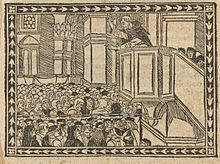San Marco, Florence
| Basilica di San Marco | |
|---|---|
 The façade of the church of San Marco | |
 | |
| Architecture | |
| Architectural type | Neoclassical |
| Years built | 12th – 18th century |
San Marco is a religious complex in Florence, Italy. It comprises a church and a convent. The convent, which is now the Museo Nazionale di San Marco, has three claims to fame. During the 15th century it was home to two famous Dominicans, the painter Fra Angelico and the preacher Girolamo Savonarola. Furthermore, the church houses the tomb of Pico Della Mirandola, a Renaissance philosopher and the so called "Father of Humanism."
History
Sylvestrines
The present convent occupies the site where a Vallombrosian monastery existed in the 13th century, which later passed to the Sylvestrine monks. The church was used both for monastic liturgical functions and as a parish church.
From this initial period there have recently been rediscovered some traces of frescoes below floor level. In 1418 the
Dominicans
A decisive element in securing the move was the intervention of
Medici reconstruction
In 1437 Cosimo commissioned
Church
The church has a single nave with side chapels designed in the late 16th century by
Among the artworks, the most ancient is a 14th-century crucifix in the counter-façade. The crucifix on the high altar (1425–1428) is by Fra Angelico. Over the first altar to the right is St. Thomas Praying by Santi di Tito from 1593, while over the second altar is a Madonna with Saints by Fra Bartolomeo.
Convent

The work was planned according to arrangements that took account of simplicity and practicality, but were of great elegance: a sober, though comfortable, Renaissance edifice. The internal walls were covered in whitewashed plaster, layout centred on two cloisters (named after Saint Antoninus and Saint Dominic), with the usual conventual features of a chapter house, two refectories and guest quarters on the ground level. On the upper floor were the friars’ cells, small walled enclosures overarched by a single trussed roof. The cloisters, chapter house and dorters (or dormitories), in the form described, must have been finished by 1440–1441. The South dormitory, which overlooks Piazza San Marco, was completed in 1442. Work on the rest of the convent went on until 1452.

Cosimo de' Medici had a cell in the convent, adjacent to those of the friars, for his personal retreat. These cells of the friars' dorter or dormitory, including that of Cosimo, and many other walls were decorated by Fra Angelico in collaboration with others, including Benozzo Gozzoli.
An outstanding feature of the convent is the library on the first floor.
Savonarola era

In addition to
Having become prior of the convent, Savonarolo unleashed a fierce campaign against the Florentines’ morals and their ostentation of luxury. He was to fall foul of the court of
Recent times
The convent was confiscated from the Dominicans in 1808, during the Napoleonic Wars, and again in 1866, when it was seized by the new Kingdom of Italy, whose temporary capital was Florence.
Until recently San Marco still housed a community of Dominican friars, who occupied the Western part of the complex adjacent to the larger cloister. In 2014 the few friars remaining were transferred to join the community at Santa Maria Novella in the city.
The convent is now constituted as the Museo Nazionale di San Marco. The entrance to the museum is from the so-called Cloister of St. Antoninus, decorated with frescoes by Bernardino Poccetti in the 16th–17th century.
References
- ^ Ullman, B (1972). The public library of Renaissance Florence. Padova: Editrice Antenore.
External links
43°46′43″N 11°15′32″E / 43.77847325072136°N 11.259024442660994°E

